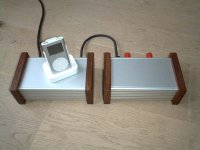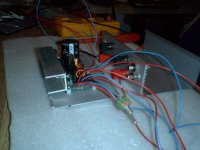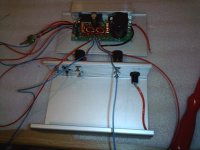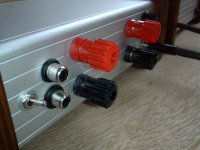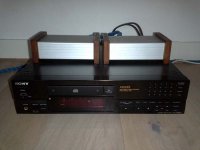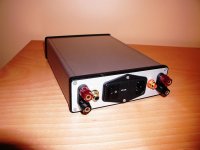After finishing my amp6 a month ago, I decided two put the amp in two identical cases; one for the toroid and one for the amp itself. Enjoy the pics.
Oh sorry, a comment on sound quality of course.
Clarity, impulsive dynamics, firm bass are the key words. Also very quiet without input on my Fostex108ES equipped Buschhorns
Oh sorry, a comment on sound quality of course.
Clarity, impulsive dynamics, firm bass are the key words. Also very quiet without input on my Fostex108ES equipped Buschhorns
Attachments
DocLorren said:After finishing my amp6 a month ago, I decided two put the amp in two identical cases; one for the toroid and one for the amp itself.
thanks for a great build.
what would be required to install the on/off, and volume attenuator? Is the toroid case act as a power supply? (I am totally a newbie that's why I had trouble assembling amp6BASIC.
gychang
Thanks guys. Tomorrow I will put a little more information on this thread about the building process, component choice / cost and some troubleshooting.
Re: Re: AMP6 in twin cases
Yes.
Very little.
http://www.michael.mardis.com/sonic/start.html
Click "Input Mods" link and then the Auricap image under "VERSION 3 'STEALTH'"
Here's how it will look in practice.
http://mywebpages.comcast.net/ampbox/page2.html
gychang said:
Is the toroid case act as a power supply?
Yes.
gychang said:
what would be required to install the on/off, and volume attenuator?
Very little.
http://www.michael.mardis.com/sonic/start.html
Click "Input Mods" link and then the Auricap image under "VERSION 3 'STEALTH'"
Here's how it will look in practice.
http://mywebpages.comcast.net/ampbox/page2.html
A little more info on this Amp6
As you will probably know, Jan from www.41hz.com is a nice guy and doing business with him is without problems. After ordering and receiving the amp6 kit (39 euros), assembly was without much trouble. Jan also supplies a pdf file with instructions which will help you through the process. All components are nicely packed in little bags with descriptions. Nine diodes are the only SMD components and reasonably easy to solder on the PCB. All the other components are through-hole and with the possible exception of the tripath TA2020 should not cause too much trouble. A regulated PSU is onboard so just add a transformer. I used a 120VA 15Volt toroid and connected the secondaries to deliver 8Amps max. During testing a 200mA fuse is recommended. As has been observed before, do not use a fuse of this value but at least a 1A fuse. The current rush-in into the 15.000uF cap is just too much. Furthermore, the mosfets used to drive the leds must be rotated 180 degrees, thus face the other way, for them (and therefore the leds) to function! After first power-up I connected an iPod and some pc-speakers and, oh yes, music was playing. However, at higher volume a ticking noise became apparent. This ticking was also related to a slight movement of the Tripath chip. After resoldering all pins this problem was solved. I used a small aluminum U-shaped bar to act as a heatsink for the voltage regulator and tripath chip. For short periods of testing the heatsink may not be necessary since both get only warm to the touch. The regulator dissipates energy also during standby, the Tripath only during amplification. The onboard rectifier does not get warm at all. I used aluminum Hammond cases (160*100*50mm) from www.conrad.nl but was a bit appalled by the plastic side-panels. Using wooden side panels would give a nice touch so I sawed some plywood (70*120*18mm) and after staining and waxing the finish now is identical to my Buschhorn speakers. All other small parts (rca connectors, fuseholder with 5A fuse, powercord, low-voltage powerconnector, speaker connectors, sleeping mode switch etcetc.) were also obtained from Conrad and the parts-bin. The toroid was a very tight fit and I made the mistake of making a loop through the centerbolt. Not good! It got very warm and smelly in a few seconds before I found out what I had done wrong. Removing the bolt and strapping down the toroid with some string tie-wraps solved yet another ad-hoc problem. No hum, no heating-up; just a clean supply of 15 Volt / 8A AC to the onboard rectifier in the other box. And now it is just playing very satisfying music using the old trusted Sony CDP-X222ES as the source, through Cat5 braided speaker cables connected to my Buschhorns with Fostex FE108ES drivers. No filters or BSC circuits at all and only minimal damping directly behind the driver means hefty dynamics, a very transparent sound and, surprise..., lots of bass. Especially compared to my, admittedly unmodified, SI T-amp the lower regions are much better represented. Mids and highs are just more dynamic and smooth but otherwise somewhat comparable to the stock SI T-amp.
Total cost: kit from 41hz.com 39 euros, 120VA toroid 22 euros, 2 cases 29 euros, small parts and wood around 10 euros. Total cost: approximately 100 euros. Time invested: around 8-10 hours. End result: priceless!
As you will probably know, Jan from www.41hz.com is a nice guy and doing business with him is without problems. After ordering and receiving the amp6 kit (39 euros), assembly was without much trouble. Jan also supplies a pdf file with instructions which will help you through the process. All components are nicely packed in little bags with descriptions. Nine diodes are the only SMD components and reasonably easy to solder on the PCB. All the other components are through-hole and with the possible exception of the tripath TA2020 should not cause too much trouble. A regulated PSU is onboard so just add a transformer. I used a 120VA 15Volt toroid and connected the secondaries to deliver 8Amps max. During testing a 200mA fuse is recommended. As has been observed before, do not use a fuse of this value but at least a 1A fuse. The current rush-in into the 15.000uF cap is just too much. Furthermore, the mosfets used to drive the leds must be rotated 180 degrees, thus face the other way, for them (and therefore the leds) to function! After first power-up I connected an iPod and some pc-speakers and, oh yes, music was playing. However, at higher volume a ticking noise became apparent. This ticking was also related to a slight movement of the Tripath chip. After resoldering all pins this problem was solved. I used a small aluminum U-shaped bar to act as a heatsink for the voltage regulator and tripath chip. For short periods of testing the heatsink may not be necessary since both get only warm to the touch. The regulator dissipates energy also during standby, the Tripath only during amplification. The onboard rectifier does not get warm at all. I used aluminum Hammond cases (160*100*50mm) from www.conrad.nl but was a bit appalled by the plastic side-panels. Using wooden side panels would give a nice touch so I sawed some plywood (70*120*18mm) and after staining and waxing the finish now is identical to my Buschhorn speakers. All other small parts (rca connectors, fuseholder with 5A fuse, powercord, low-voltage powerconnector, speaker connectors, sleeping mode switch etcetc.) were also obtained from Conrad and the parts-bin. The toroid was a very tight fit and I made the mistake of making a loop through the centerbolt. Not good! It got very warm and smelly in a few seconds before I found out what I had done wrong. Removing the bolt and strapping down the toroid with some string tie-wraps solved yet another ad-hoc problem. No hum, no heating-up; just a clean supply of 15 Volt / 8A AC to the onboard rectifier in the other box. And now it is just playing very satisfying music using the old trusted Sony CDP-X222ES as the source, through Cat5 braided speaker cables connected to my Buschhorns with Fostex FE108ES drivers. No filters or BSC circuits at all and only minimal damping directly behind the driver means hefty dynamics, a very transparent sound and, surprise..., lots of bass. Especially compared to my, admittedly unmodified, SI T-amp the lower regions are much better represented. Mids and highs are just more dynamic and smooth but otherwise somewhat comparable to the stock SI T-amp.
Total cost: kit from 41hz.com 39 euros, 120VA toroid 22 euros, 2 cases 29 euros, small parts and wood around 10 euros. Total cost: approximately 100 euros. Time invested: around 8-10 hours. End result: priceless!
Attachments
Sounds like you had a "Shorted Turn" on your power supply. I always wanted to know what happens during a Shorted Turns event - no harm to your torroid? You can easily melt your torroid wrap, if not your entire coil, but sounds like its good to go.
Anyway, thise Hammond boxes are great...I use them all the time. You can get the same boxes with metal endplates too
Anyway, thise Hammond boxes are great...I use them all the time. You can get the same boxes with metal endplates too
Attachments
No, just a drop in output voltage, nasty smell and a lot of heat but no permanent damage. And of course, another important lesson learned.
Those hammond boxes do indeed look great - you can also take off the plastic front/rear ends and just use the metal ones - looks better still ;-)
Nice work on the amps!
- John
Nice work on the amps!
- John
hi doc,
that's nice work, i too didn't like the plastic end caps, the wood caps look great, i have an amp6 basic . thinking of using those cases one for the power amp and the other as passive pre amp
rgds
that's nice work, i too didn't like the plastic end caps, the wood caps look great, i have an amp6 basic . thinking of using those cases one for the power amp and the other as passive pre amp
rgds
- Status
- Not open for further replies.
- Home
- Amplifiers
- Class D
- AMP6 in twin cases

